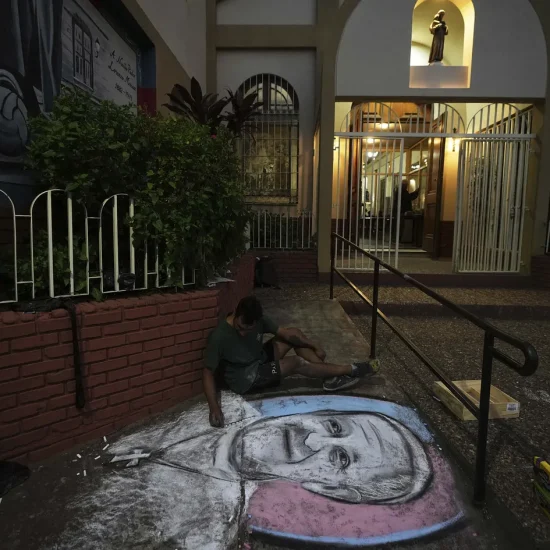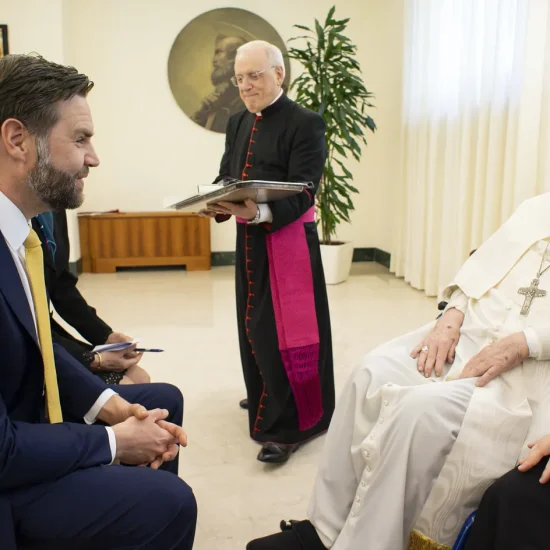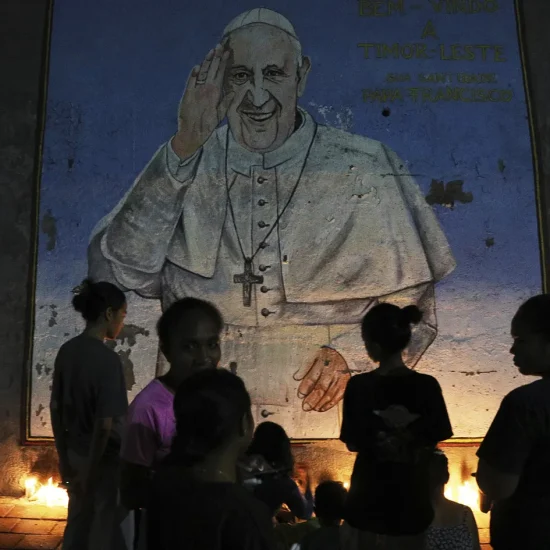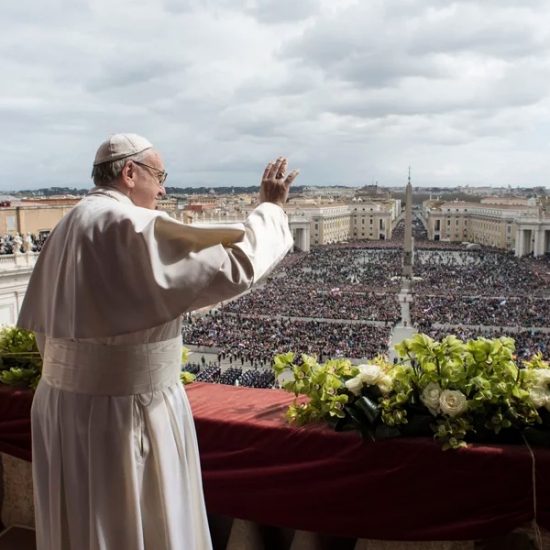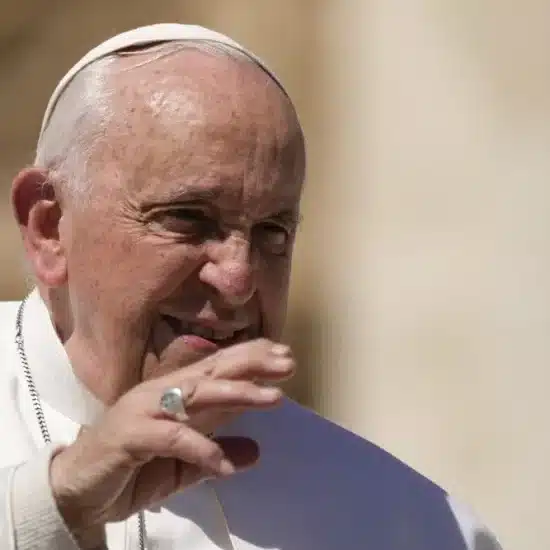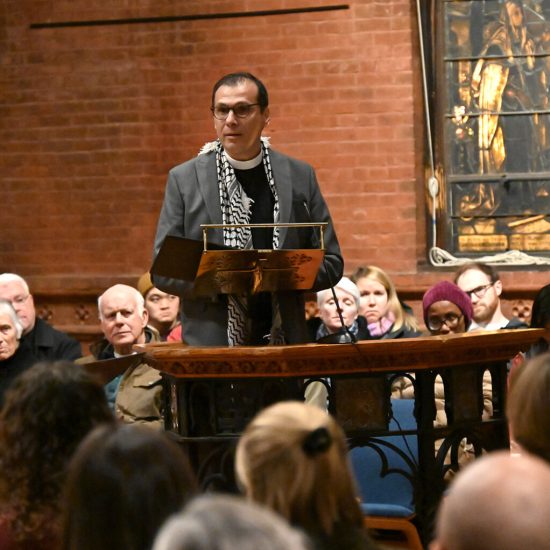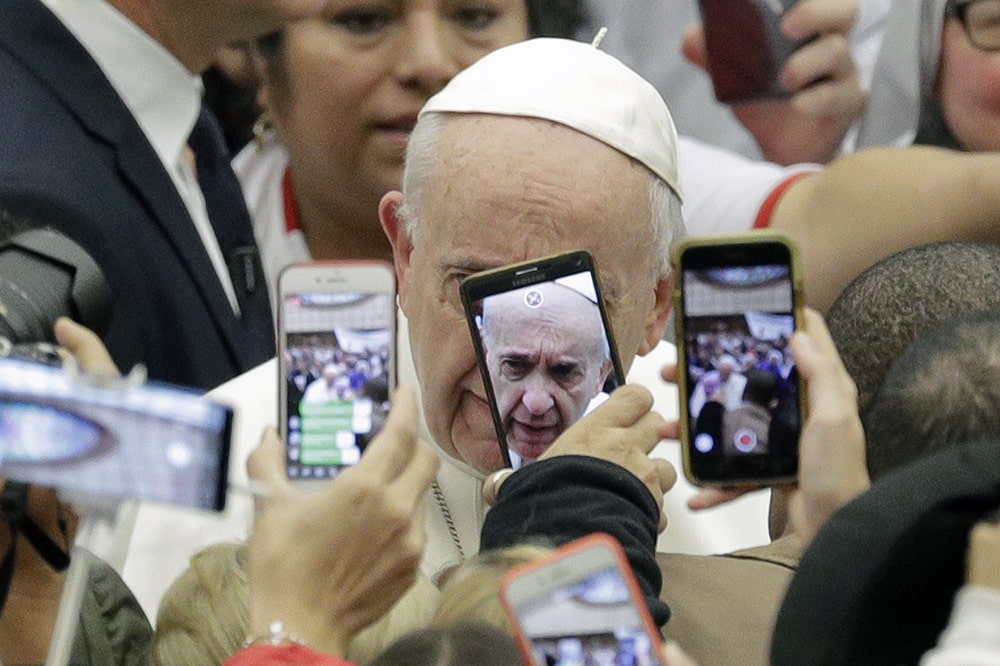

Pope Francis is framed by cellphones as he arrives for his weekly general audience, in the Pope Paul VI hall, at the Vatican on Jan. 9, 2019. (AP Photo/Andrew Medichini)
VATICAN CITY (RNS) — Seven years ago on Dec. 12, then-Pope Benedict XVI published his first tweet before a crowd of prelates and faithful. With a tap on an iPad, the pontificate was ushered into the world of social media, creating a new space for evangelization and papal communication.
“Dear friends, I am pleased to get in touch with you through Twitter. Thank you for your generous response. I bless all of you from my heart,” Benedict XVI tweeted to his already 1 million followers 10 days later.
The name of the account, Pontifex, is Latin and means bridge builder. The aim was to make the Twitter handle vague enough to be taken over by a successor, and incidentally the name couldn’t have been better suited for the next pope, Francis, who made “build bridges, not walls” the motto of his pontificate.
Since 2012, the pope’s Twitter account has undergone several transformations. Not only the differing social media presence of the two popes, but also in terms of engagement.
Initially, Benedict encouraged his followers to send him questions regarding matters of faith via #AskPontifex. He answered the many thousands of questions that were sent, from how to pray in today’s fast-paced world, to holding on to faith amid the scandals hitting the Catholic Church.
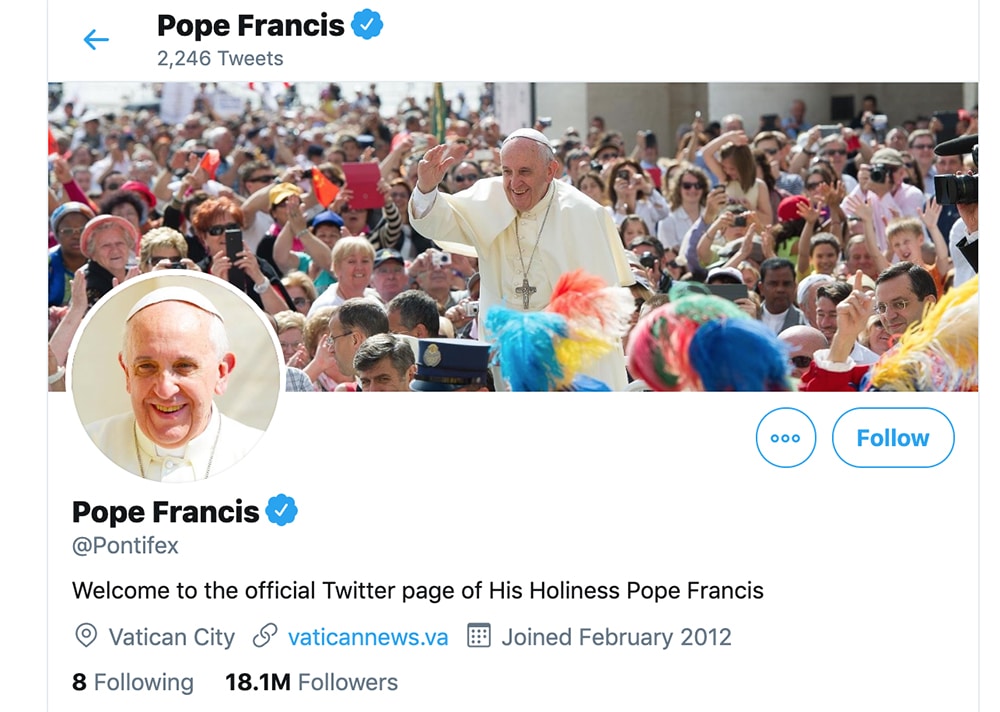
Pope Francis’ official Twitter page. Screengrab
But the responses weren’t all positive. Beyond the ever-present Twitter trolls and those hostile to Catholicism, some believers questioned why the successor of St. Peter was becoming involved in a platform they viewed as venial and trifling.
For every like, retweet and prayer emoji sent to the papal account, there were hundreds of messages of scorn, ridicule or incredulity. As a result, the Pontifex account, having dipped its feet into the murky waters of the Twittersphere, slowly retreated, preferring mere presence over engagement.
“I think the original idea was that (Twitter) would be a place where people could ask the pope questions,” said Robert Mickens, a veteran Vatican reporter at la Croix International, in an email to Religion News Service on Wednesday (Dec. 11). “But that was soon abandoned, probably because of the Pandora’s box it opened with controversy, nastiness and so forth.”
While the papal tweets may not be the most hard-hitting or meme-friendly, there are still a handful of cases when the popes made at least splashes, if not waves, on Twitter.
Apart from his historic first tweet, Benedict shook the world with his last one. “Thank you for all your love and support,” he tweeted on Feb. 28, 2013, after his resignation. “May you always experience the joy that comes from putting Christ at the center of your lives.”
(All tweets by Benedict have been removed from the Pontifex account and archived by the Vatican.)
In June 2015, Francis garnered a swarm of responses — both positive and negative — when he posted an uncharacteristically aggressive tweet addressing the environment. “The earth, our home, is beginning to look more and more like an immense pile of filth,” he tweeted.
The earth, our home, is beginning to look more and more like an immense pile of filth.
— Pope Francis (@Pontifex) June 18, 2015
While some responded with comments applauding the pope’s stance on climate change and environmental issues, many others called the tweet mere “propaganda” and accused Francis of being too political.
His tweets promoting young people, immigrants and the importance of life from conception to natural death have been among the most successful, often retweeted thousands of times. One meme-worthy tweet came during the 2019 World Youth Day. In Francis’ zeal to engage young people with their tools and language, he called the Virgin Mary the “first influencer” during his speech and in a tweet.
With her “yes”, Mary became the most influential woman in history. Without social networks, she became the first “influencer”: the “influencer” of God. #Panama2019
— Pope Francis (@Pontifex) January 27, 2019
Today the papal Twitter account serves primarily as an echo chamber of the pope’s messages, often pulling sentences out of official speeches and audiences. Compared to global political leaders, @Pontifex doesn’t directly interact with responses nor converse other social media users.
Still, thanks to his down-to-earth presence, Pope Francis has amassed almost 50 million Twitter followers.
Not unlike other religious leaders — such as the Dalai Lama, who joined Twitter in 2010 — the pope uses the platform to distribute his spiritual message and offers prayers for those who suffer because of poverty, war or catastrophes.
Yet, a perhaps little-known fact is that neither Benedict nor Francis directly manages his social media accounts, which instead are handled by employees at the Vatican’s communication department.
“It’s not like the pope or the Vatican is making news or announcing new initiatives on Twitter, like some other world leaders have done. One thinks of President Trump for example,” Mickens wrote. “Rather, the Vatican uses Twitter as a way to make the pope, his teachings and concerns part of the forum of ideas and discussions in this sector of social media.”
Understanding that @Pontifex is a Vatican operation, instead of directly in the hands of the pope, is crucial for interpreting its daily tweets. Tweets are usually scheduled for the week, so trying to search for a deeper meaning in a given tweet or tying it to the news of the day can be misleading.
Vatican employees also decide what hashtags to use, which recently led to a comic mishap. In an Oct. 13 tweet thanking God for new #Saints, the Pontifex account accidentally pulled in associated emoji for the hashtag — that of the New Orleans Saints football team, which on the same day happened to win a decisive game against the Jacksonville Jaguars.
Today we give thanks to the Lord for our new #Saints. They walked by faith and now we invoke their intercession.
— Pope Francis (@Pontifex) October 13, 2019
The responses were, unsurprisingly, full of humor, head slap emojis and more than a few football memes.
It’s true that Pope Francis has been more hands-on when it comes to social media, creating Instagram accounts and often overseeing the tweets before they are sent out. But while Twitter has drastically changed in the past seven years — becoming more and more like a portable 24-hour TV news feed — the Vatican’s approach has remained mostly unchanged, only timidly adding more video and picture content to its tweets.
“Who knows? Perhaps a future pope and his communications people will use Twitter and other social media as a forum for dialogue,” Mickens wrote. “But for now, this is not happening.”

